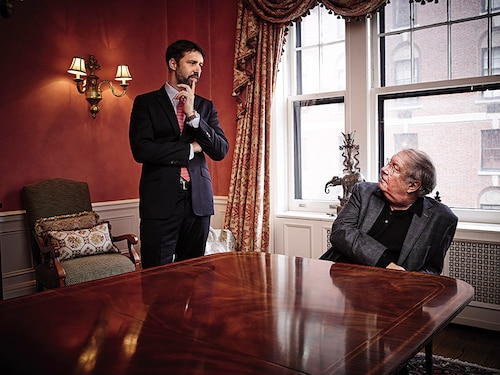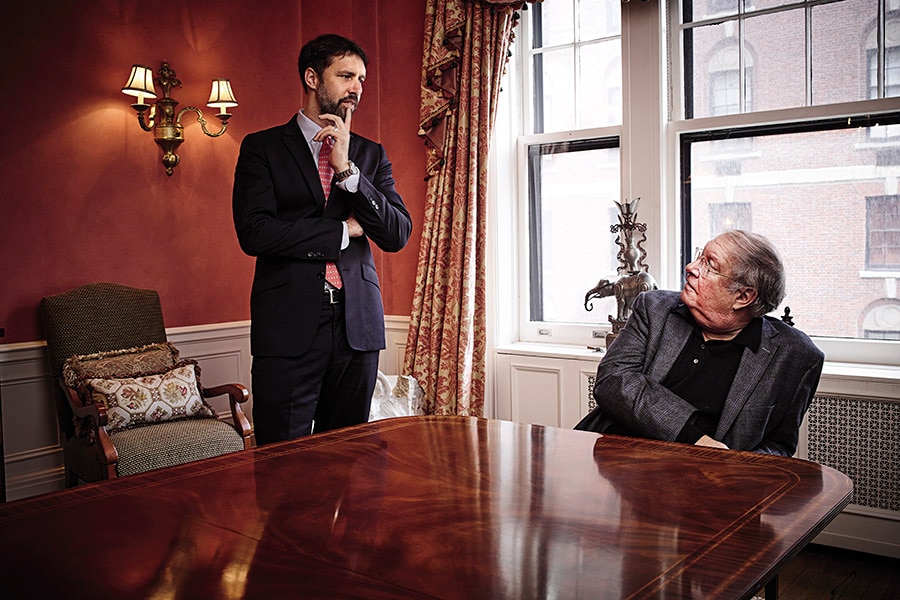Bill Miller: The unreformed stock picker
Bill Miller beat the market for 15 straight years before he was hammered by the financial crisis. Now the legendary investor is happily running money on his own terms—long on risk and big ideas


 Old and bold: Bill Miller (right) remains an aggressive risktaker. His son, Bill Miller IV, has a more cautious style
Old and bold: Bill Miller (right) remains an aggressive risktaker. His son, Bill Miller IV, has a more cautious style
Image: David Yellen for Forbes
In the living room of his seven-room Park Avenue apartment, 67-year-old investing legend Bill Miller wears a slightly rumpled black golf shirt underneath a blue-and-gray chequered blazer from Dillard’s. On walls painted burgundy and colonial blue hang oil paintings depicting 20th-century life, including Wall Street after the 1929 crash and drunks on the Bowery in the 1940s. Throughout the flat, heavy drapes, candles, plush couches and ornate chairs create a dark, frozen-in-time atmosphere.
It’s all a bit surprising considering that Restoration Hardware, which peddles high-end modern furniture, is the largest holding in Miller’s $1.5 billion Opportunity Trust—and a big reason the fund was up 20 percent for the first half of 2017, nearly twice the S&P 500’s gain.
Truth is, Miller has never cared much about labels or current fashions. Beginning in 1991, his Legg Mason Capital Management Value Trust beat the S&P 500 for 15 years in a row partly because he defined “value” his own way. In addition to stocks with low price-to-earnings and price-to-book multiples, he bought those whose future cash flow he deemed undervalued based on his analysis of big technological and economic trends. After Amazon went public in 1997, Miller’s fund eventually became the second-largest holder after founder and CEO Jeff Bezos. When others fled tech stocks after the dotcom crash, he doubled down, scooping up a chunk of search upstart Google in its 2004 public offering.
As investors chased returns, Value Trust’s assets grew to more than $70 billion, and Miller became the most famous active fund manager since Peter Lynch stepped away from the Fidelity Magellan fund in 1990. Yet, heading into the 2007–08 financial crisis, Miller owned everything that would soon turn toxic: Subprime mortgage lender Countrywide, now-defunct Lehman Brothers and Bear Stearns, bond insurers, home builders and even AIG. When conditions worsened, he once again doubled down, mistakenly believing (he now says) the Federal Reserve could end the crisis quickly by injecting liquidity, when the real problem was asset values.
By the end of 2008, Value Trust had lost nearly two-thirds of its value, wiping out most of Miller’s outperformance over the previous two decades. It came roaring back in 2009 and 2010. But investors had already abandoned the fund, and Miller was the poster boy for the folly of paying active managers high fees to beat the market when hot hands inevitably cool and low-cost index funds allow you to capture the market’s long-term gains.
Since then, the flight to index funds has accelerated, and Miller and Baltimore-based Legg Mason have parted ways. In 2012, he was replaced by understudy Sam Peters as manager of the Value Trust (now the Clearbridge Value Trust). This past February, Miller completed the buyout of a partnership he had formed with Legg Mason to manage the Opportunity Trust and a small income fund. His family-owned Miller Value Partners now runs the Opportunity Trust, a separate $120 million hedge fund and the $116 million Miller Income Fund, managed by his son, 36-year-old Bill Miller IV.
undefinedMiller’s Legg Mason beat the S&P 500 for 15 years in a row because he defined value his own way[/bq]
Miller is the biggest investor in all three funds and can do what he likes—thinking big thoughts and placing big and often contrarian bets—without worrying about marketing or bosses. “I was at Legg Mason for 35 years and ran the Value Trust for 30 years. This is better,” he says. “Here it is much more about just growing the assets and not trying to get a constant inflow of clients and doing pitches.” Still, outsiders ready to pay Miller’s fees are welcome to come along. Opportunity’s most popular C class shares have a 1 percent load and annual expenses of 2.13 percent. The fund’s 21 percent average return over the past five years ranks it in the top 2 percent of midcap equity funds, yet Morningstar gives it a neutral rating because of its extreme volatility.
While Miller makes his legal residence in state-income-tax-free Florida, his firm operates out of Baltimore with 15 employees. His 25th-floor office there overlooking Baltimore’s Inner Harbor is a sort of stock-picking shrine. Against one wall is a replica of the sound board used by CNBC’s Jim Cramer on Mad Money, with 27 red levers that release sounds ranging from a crying baby to the “Ka-ching!” of a cash register. On another wall hangs a photograph of Silky Sullivan, a racehorse legendary for his come-from-behind wins—like the years during Miller’s “streak” when his fund roared back from underperformance to close the year ahead of the market.
Miller’s holdings reflect, as always, his intellectual breadth and appetite for both bargains and risk. Before joining Legg Mason in 1981, he spent three years as an Army intelligence officer. For a time, he pursued a PhD in philosophy at Johns Hopkins. At Legg Mason, he was the in-house professor, creating reading lists for analysts and leading weekend trips to New Mexico’s Santa Fe Institute for sessions on everything from advances in computing to physics, biotechnology and economics. Longtime colleague Robert Hagstrom, now manager of the EquityCompass Global Leaders Portfolio, says Miller’s curiosity served him well at the dawn of the PC and internet age, when traditional measures didn’t capture the potential of companies like Dell, one of his best picks. “He was looking at the world differently than your traditional money manager.”
Indeed, Miller still has a keen eye for change. In 2014, he put 1 percent of his net worth into Bitcoin, judging that the digital currency’s potential for largescale economic disruption outweighed the risk of a total loss. He’s up nearly tenfold, and Bitcoin is now a top holding of his hedge fund.
As for his Opportunity fund, its second-largest position is in Apple call options, purchased before the stock started rising this year, and it has a large Amazon stake. “Warren Buffett has said Jeff Bezos is the best businessperson he ever met but he missed Amazon [as an investment]. Well, he hasn’t missed it,” Miller says. He expects Amazon’s market cap to rise five- or six-fold within a decade.
Then there’s Miller the bargain hunter. Last year, with Restoration Hardware’s profits and stock reeling from heavy discounting, Miller bought in at an average of $32 a share. Within months, CEO Gary Friedman unveiled turnaround plans and $1 billion in stock buybacks. Restoration now trades around $65.
Miller prides himself on making such calls ahead of other investors. “The amount of information I need to come to a conclusion tends to be a lot less,’’ he says. His long-term bet on the consolidating airline industry (he owns Delta, United Continental and American) recently got a boost when Buffett disclosed an $8 billion-plus investment in airline stocks after criticising these carriers as dead money for years. (At Berkshire Hathaway’s 2013 shareholder meeting, Miller quizzed Buffett on why he wasn’t in airlines.) Miller concedes he bought Valeant Pharmaceuticals “way too soon”, building up a position in the 30s it’s now around $17. He still likes the concept—rolling up specialty pharma products without spending much on R&D—but worries about Valeant’s debt.
Still, Miller makes no apologies for bold bets. “What I’m trying to do with the Opportunity fund is look for things that can go up many times. I am not trying to make 20 percent.” He argues that investors shell-shocked by the financial crisis are still “risk and volatility phobic” and have created a “safety bubble”.
Miller’s passion beyond funds? Rare books. Here, too, he mixes intellectualism and bargain hunting—his collection, built over two decades, costs what one masterpiece painting might, he says. He owns Shakespeare’s first folio and first editions of everything from Herman Melville’s Moby-Dick to Adam Smith’s The Wealth of Nations. A few years ago, Miller shelled out more than $1 million for Bob Dylan’s lyrics to his 1960s classic ‘Blowin’ in the Wind’, handwritten on stationery from the Taft Hotel. Last October, Dylan became the first songwriter to win the Nobel Prize in Literature. Once again, Miller was ahead of the trend.
First Published: Aug 04, 2017, 06:59
Subscribe Now